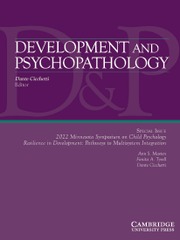Article contents
Kindergarten antecedents of the developmental course of active and passive parental monitoring strategies during middle childhood and adolescence
Published online by Cambridge University Press: 13 November 2019
Abstract
Decades of research have highlighted the significance of parenting in children's development, yet few studies have focused specifically on the development of parental monitoring strategies in diverse families living in at-risk neighborhoods. The current study investigated the development of active (i.e., parental discussions and curfew rules) and passive (i.e., child communication with parents) parental monitoring strategies across different developmental periods (middle childhood and adolescence; Grades 4–5 and 7–11) as well as individual (child, parent), family, and contextual antecedents (measured in kindergarten) of this parenting behavior. Using an ecological approach, this study evaluated longitudinal data from 753 participants in the Fast Track Project, a multisite study directed at the development and prevention of conduct problems in at-risk children. Latent trajectory modeling results identified little to no mean growth in these monitoring strategies over time, suggesting that families living in at-risk environments may engage in consistent levels of monitoring strategies to ensure children's safety and well-being. Findings also identified several kindergarten antecedents of the growth factors of these parental monitoring strategies including (a) early child conduct problems; (b) parental warmth/involvement, satisfaction, and efficacy; and (c) parent–child relationship quality. These predictive effects largely highlighted the important role of early parenting behaviors on later levels of and growth in parental monitoring strategies. These findings have important implications for potential prevention and intervention targets to promote the development of parental monitoring strategies among families living in more at-risk contexts.
Keywords
Information
- Type
- Special Issue Articles
- Information
- Development and Psychopathology , Volume 31 , Special Issue 5: Honoring the Contributions and Legacy of Thomas Dishion , December 2019 , pp. 1675 - 1694
- Copyright
- Copyright © Cambridge University Press 2019
Footnotes
A preliminary version of this article was presented at the Society for Research in Adolescence biennial meeting, Vancouver, British Columbia, March 2012. This work used data from the Fast Track project (for additional information concerning Fast Track, see http://www.fasttrackproject.org).
References
- 11
- Cited by

